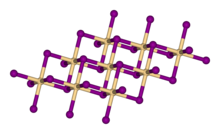Manganese(II) bromide is the chemical compound composed of manganese and bromine with the formula MnBr2.

| |

| |
| Names | |
|---|---|
| IUPAC name
Manganese(II) bromide
| |
| Identifiers | |
| |
3D model (JSmol)
|
|
| ChemSpider | |
| ECHA InfoCard | 100.033.251 |
| EC Number |
|
PubChem CID
|
|
| UNII |
|
CompTox Dashboard (EPA)
|
|
| |
| |
| Properties | |
| MnBr2 | |
| Molar mass | 214.746 g/mol (anhydrous) 286.60 g/mol (tetrahydrate) |
| Appearance | pink crystalline |
| Density | 4.385 g/cm3 |
| Melting point | 698 °C (1,288 °F; 971 K) (anhydrous) 64 °C (tetrahydrate) |
| Boiling point | 1,027 °C (1,881 °F; 1,300 K) |
| 146 g/100 mL at 20 °C[1] | |
| +13,900·10−6 cm3/mol | |
| Structure | |
| Trigonal, hP3, SpaceGroup = P-3m1, No. 164 | |
| octahedral | |
| Hazards | |
| GHS labelling: | |

| |
| Warning | |
| H302, H312, H332 | |
| P280 | |
| NFPA 704 (fire diamond) | |
| Flash point | Non-flammable |
| Related compounds | |
Other anions
|
Manganese(II) fluoride Manganese(II) chloride Manganese(II) iodide |
Other cations
|
Iron(II) bromide Cobalt(II) bromide Manganese(III) bromide |
Except where otherwise noted, data are given for materials in their standard state (at 25 °C [77 °F], 100 kPa).
| |
It can be used in place of palladium in the Stille reaction, which couples two carbon atoms using an organotin compound.[2]
References
edit- ^ http://sites.chem.colostate.edu/diverdi/all_courses/CRC%20reference%20data/solubility%20of%20inorganic%20compounds.pdf [dead link]
- ^ Cepanec, Ivica (2004). Synthesis of Biaryls. Elsevier. p. 104. ISBN 0-08-044412-1. Retrieved 2008-06-18.
